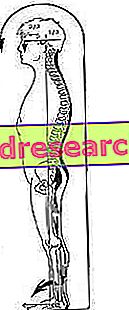Related articles: Aspergillosis
Definition
Aspergillosis is an opportunistic infection caused by members of the genus Aspergillus, which can determine a wide spectrum of diseases.
Usually not pathogens, these microscopic fungi are very widespread at an environmental level. Aspergillos are present, for example, in insulating materials of walls or ceilings, air conditioning systems or convector heaters, decomposing vegetation (heaps of fertilizer), hospital wards and airborne dust.
The organ predominantly affected by aspergillosis is the lung. Here, colonization by Aspergillus sp. it causes the appearance of abscesses, pneumonia and bronchopneumonia. In many cases, then, the lung is the focus from which the infection can spread to many other organs.
Invasive infections usually occur following the inhalation of fungal spores or occasionally through direct invasion of these through injured skin. As they enter, aspergillus invade the blood vessels, causing haemorrhagic necrosis, infarction and potential dissemination to other sites in susceptible patients.
The main risk factors for aspergillosis include: neutropenia, long-term therapies with high doses of corticosteroids or with other drugs that weaken the defense mechanisms, organ transplantation (especially that of bone marrow), hereditary disorders characterized by a defect hereditary of neutrophil function (eg chronic granulomatous disease) and AIDS.
Colonizations from Aspergillus sp. they can also be progressive chronic, non-invasive or minimally invasive . In the latter case, the pathogen tends to infect pre-existing cavitary lesions caused by previous pathologies of the lungs (eg bronchiectasis, tumor, TB and other chronic infections), paranasal sinuses or ear canals (otomycosis).
At times, focal infections result in a mycotic nodule (aspergilloma), with characteristic growth of a tangled mass of hyphae, with fibrinous exudate and a few inflammatory cells, typically encapsulated by fibrous tissue. Occasionally, there is an appreciable local invasion of tissue at the periphery, but usually the fungus implants itself and tends to grow in volume inside the pre-existing cavity. In rare cases, chronic invasive pulmonary lesions may evolve, resulting in a systemic spread in immunocompromised patients, usually in association with corticosteroid therapy.
There are also infrequent cutaneous forms of aspergillosis (called superficial primaries); these can occur in case of burns, below occlusive bandages or following corneal lesions (keratitis). Aspergillus can also cause endophthalmitis after trauma or surgery on the eye (or due to hematogenous dissemination) and endocarditis following infections of the intravascular and intracardiac prostheses (eg heart valves).
Another form is the allergic bronchopulmonary aspergillosis which consists of a hypersensitivity reaction to Aspergillus fumigatus not related to the mycotic invasion of tissues.
Most common symptoms and signs *
- Oral aphthosis
- Apnea
- Asthenia
- Pulmonary atelectasis
- Cyanosis
- Dyspnoea
- Chest pain
- Muscle pains
- hemoptysis
- Hemoptysis
- Pleural empyema
- Eosinophilia
- Temperature
- Hypercapnia
- Hyperventilation
- Headache
- Closed nose
- Multiple pulmonary nodules
- Solitary pulmonary nodule
- Pallor
- Cold
- Sense of suffocation
- Drowsiness
- Squeal
- Tachycardia
- tachypnoea
- Cough
- Skin Ulcers
Further indications
Aspergillosis occurs mainly in the form of asthma, pneumonia, sinusitis or rapidly progressive systemic disease.
- Transient lung disease outbreaks are associated with fever, headache, bronchospasm and eosinophilia. The symptoms are similar to those of acute bronchitis.
- Chronic pulmonary aspergillosis causes cough, hemoptysis and shortness of breath.
- Pulmonary invasive aspergillosis rapidly leads to progressive and ultimately fatal respiratory failure, unless it is treated promptly and aggressively.
- Extrapulmonary invasive aspergillosis begins with skin lesions, sinusitis or acute pneumonia and may involve the liver, kidneys, brain and other tissues; often, the course is fast and rapidly fatal.
- Allergic bronchopulmonary aspergillosis manifests itself clinically with bronchospasm crisis and intense dyspnea.
The diagnosis is mainly clinical and facilitated by the appearance of hemoptysis, but can be confirmed by radiological images and histopathology of clinical samples.
The treatment of invasive infections is based on the administration of antifungal drugs, such as voriconazole, amphotericin B (or its lipid formulations), caspofungin, itraconazole or flucytosine. Mycotic nodules may require surgical resection. Recurrences are frequent.



